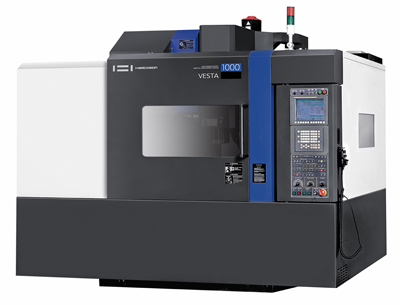Vesta 1000 Vertical Machining Center
Vesta 1000 Vertical Machining Center
Hwacheon Machinery offers its VESTA 1000 vertical machining center for stable, high-speed, precision machining and long-term productivity to job shops serving mold & die, automotive, energy, medical, and aerospace applications.

Hwacheon Machinery offers its VESTA 1000 vertical machining center for stable, high-speed, precision machining and long-term productivity to job shops serving mold & die, automotive, energy, medical, and aerospace applications. Axis travels are 1000X550X500mm, X, Y, and Z. With a table surface of 43.31" x 19.69", load capacity of over 1500 lbs, and distance from table surface to gauge plane of 5.12" to 24.8", the machines can accommodate a wide range of workpieces.
Maximum spindle speed of 12,000 rpm developed by the 25 HP motor, plus Hwacheon's adaptive software suite make the VESTA 1000 a high performance machine for fast roughing as well as highly precise finishing. The machines can be quickly programmed in Fast Mode for roughing or Precision Mode for finish machining.
The software monitors environmental and machining related variables and adjusts the machining process automatically, minimizing cycle times and optimizing machining results. Hwacheon's Machining center Tool Load Detection (HTLD) System software which constantly detects and diagnoses the tool load during machining to reduce tool wear and prevent damage, optimizing tool life.; HECC provides precise contour control for better machining efficiency; OPTIMA controls the feed rate, reducing the cycle time as much a 25 percent. To help minimize thermal displacement and to increase the life of the spindle assembly, the spindle unit is jacket and bearings are cooled.
A rapid feed (X/Y/Z of 1417/1417/1180 inch/min. permits quick positioning of the tools. A 24 or 30-position tool magazine, carrying tools up to 6" dia., 12" length offers tool-to-tool change time of just 1.5 sec, helping to reduce cycle time. Machining feed rates are to 945 ipm.
Precision roller guide ways in all axes and rigid one-piece machine bed design means the vertical machining centers from Hwacheon are designed to absorb vibration and provide optimal stability, even when hard milling.
The Hwacheon clean room assembly facility, where these super-precision, super-rigid spindles are manufactured, maintains optimal temperature and humidity, resulting in spindles that meet the toughest quality standard in the industry. All Hwacheon spindles are oil-cooled.





